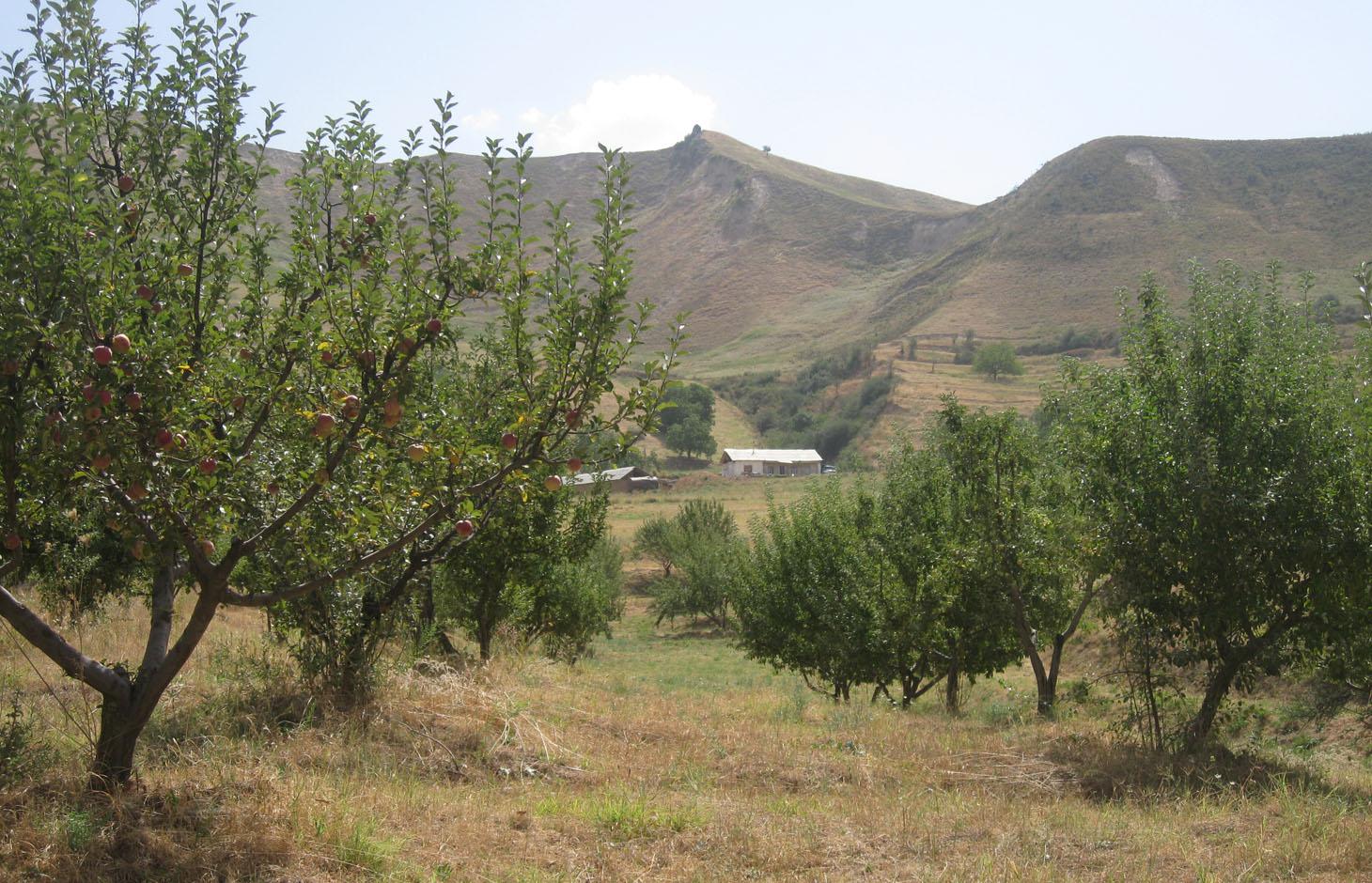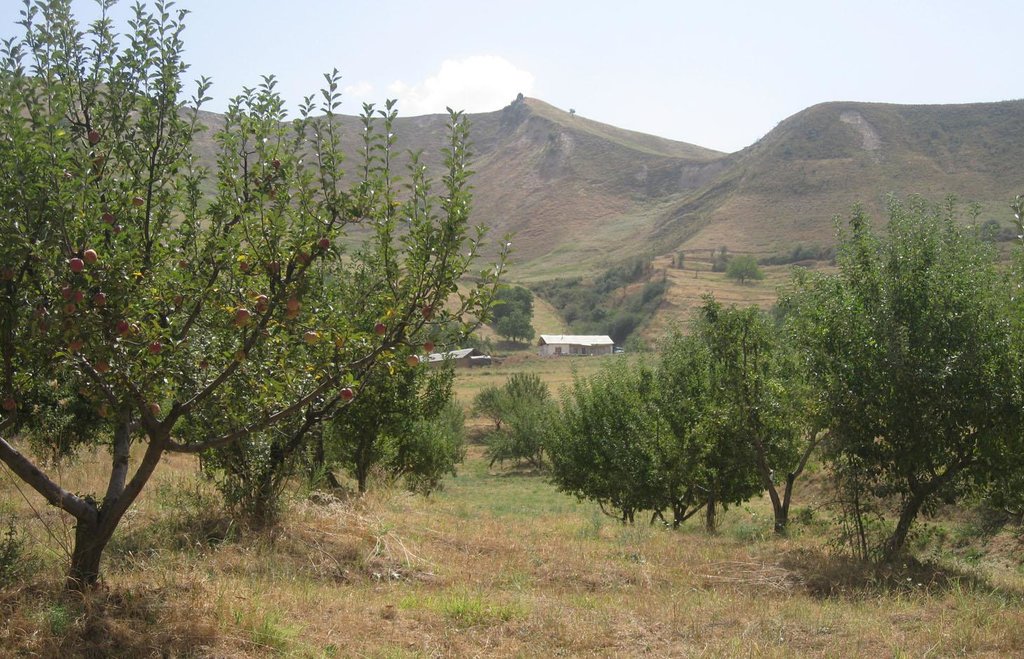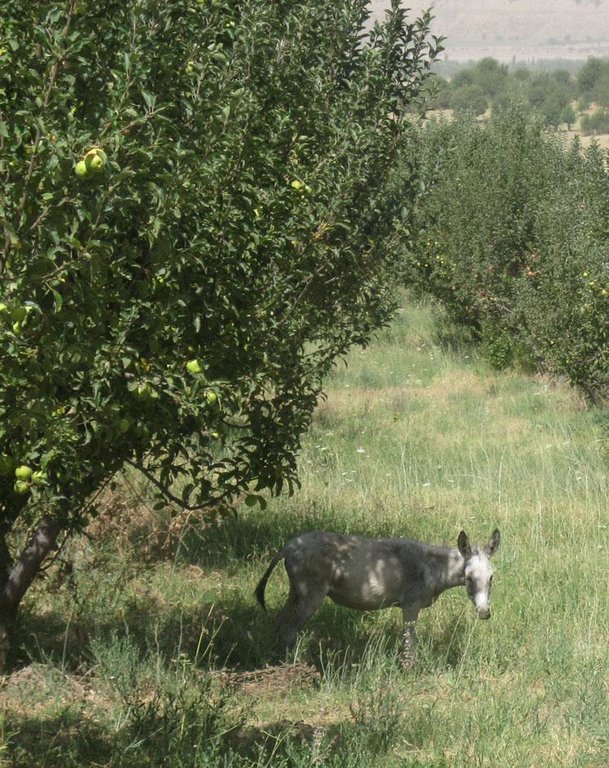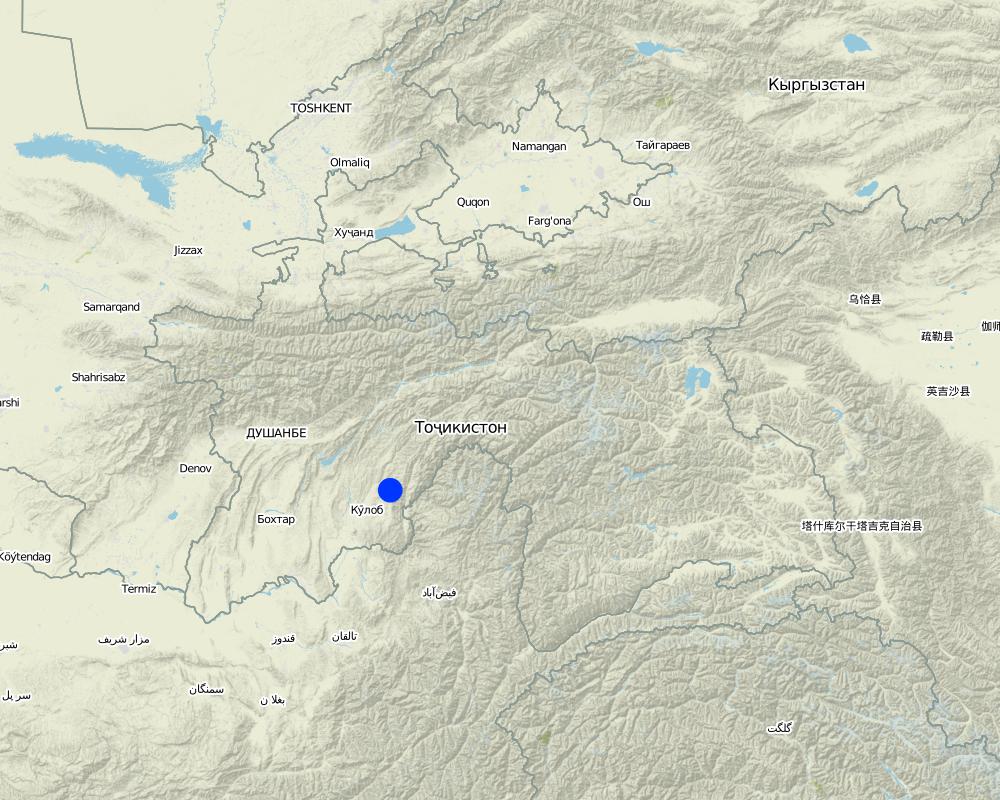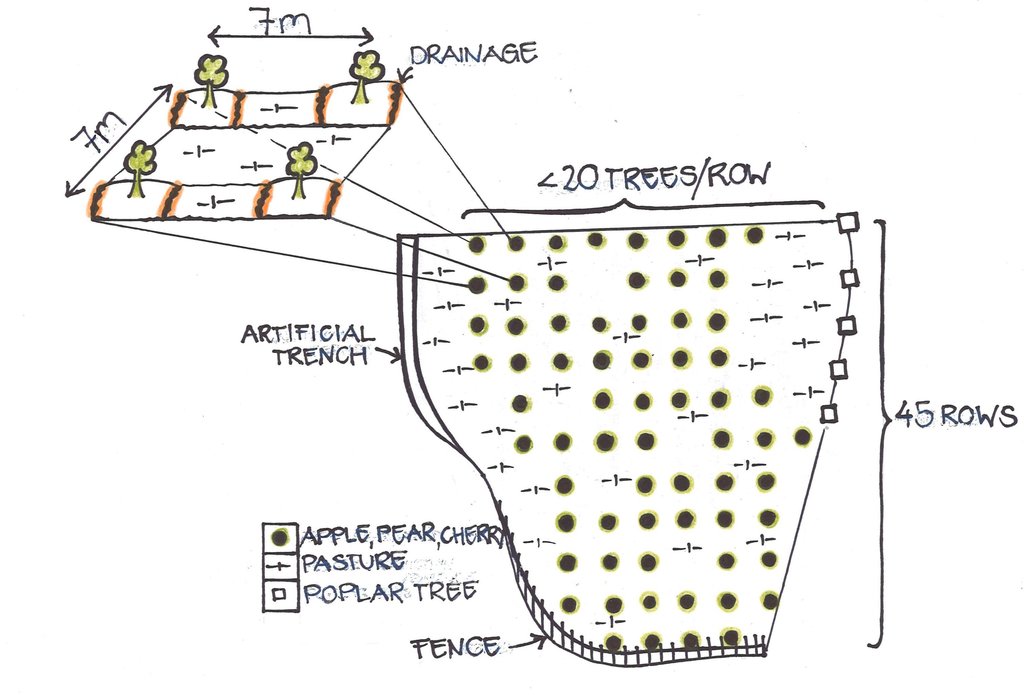Silvo-pastoralism: Orchard with integrated grazing and fodder production [塔吉克斯坦]
- 创建:
- 更新:
- 编制者: Malgorzata Conder
- 编辑者: –
- 审查者: Deborah Niggli, Alexandra Gavilano
technologies_1554 - 塔吉克斯坦
查看章节
全部展开 全部收起1. 一般信息
1.2 参与该技术评估和文件编制的资源人员和机构的联系方式
SLM专业人员:
有助于对技术进行记录/评估的机构名称(如相关)
NCCR North-South (NCCR North-South) - 吉尔吉斯斯坦1.3 关于使用通过WOCAT记录的数据的条件
编制者和关键资源人员接受有关使用通过WOCAT记录数据的条件。:
是
1.4 所述技术的可持续性声明
这里所描述的技术在土地退化方面是否存在问题,导致无法被认为是一种可持续的土地管理技术?:
否
2. SLM技术的说明
2.1 技术简介
技术定义:
Increased productivity of the land by planting fruit trees and conserving the land by restricting the access of livestock resulting in improved runoff retention
2.2 技术的详细说明
说明:
In Soviet times, this area of totally 40 ha comprised terraces and walnut trees in the steep foothills and pastures in the lower and flatter part. After the collapse of the Soviet Era, many similar areas got degraded due to uncontrolled grazing and overuse of natural resources. The area described in this documentation, in contrast, was taken over by a family in 1991. Within the whole area of 40 ha, roads were built to improve the access and 6000 trees were planted, whereof 1200 fruit trees were planted on the pasture, conversing it into an orchard.
At present, the 6 ha of orchard are mainly consisting of three types of apple (white, golden and red), some pear and cherry trees. Several trees must have dried out or have been cut, as the farmer counts currently around 1000 fruit trees. The whole orchard is combined with pasture land. The farmer let his livestock graze in the orchard, and cuts the remaining grass in autumn, if there is still left.
The integrated orchard with pastureland and fodder production is partially fenced to hinder livestock entering his property. Furthermore, the orchard is within the range of vision which allows the farmer`s family to guard it.
The farmer who is managing the orchard today obtained the property of his father in order to continue the family project by his own initiative. By farming he ensures the livelihood of his family. Hence, he felt responsible to progress and improve the quality of life of his own family. The main reason for establishing the orchard within the grassland and to install fences, was to increase productivity of the land, bringin along beneficial effects on soil quality. According to his land users certificate, the main purpose of this land is to provide the local market with food products.
After planting, some of the seedlings were stolen or eaten by livestock from neighbouring farms. Initial labour input in the newly established orchard consisted of getting and planting the seedlings and applying pesticides. The trees are being maintained by pruning. Soil is loosened and drainage provided to increase water infiltration and to protect the trees additionally from parasites. The pasture is grazed by the livestock of the farmer. As the family only has a small number of livestock, grass is cut afterwards and used as fodder. Half of the fodder harvest belongs to the hired worker, the other half belongs to the farmer. The other tasks are executed by the farmer and his family.
The climate is semi-arid with precipitation (800mm totally) mainly during winter and spring time. Altitude is around 1380 m asl. The plot is located at the foothill, with the wider riverbed and fan downstream and overgrazed hills upstream. Bordering with the property from above, a steep slope with a dense vegetation of grafted fruit trees and walnut trees stabilizes the soil.The farmer is living with the family on the property, near the village of Momandion. In the past many livestock from nearby entered the property and grazed there. Through better control and fences less livestock is entering. The property is located directly on the road to Muminabad, the center of the District with a market- 2 km away.Considering the establishment costs of the orchard, the farmer is a fairly whealthy man, nevertheless he had to rely on his family and friends in terms of the working input.The establishment phase was a time and money consuming
2.3 技术照片
2.5 已应用该技术的、本评估所涵盖的国家/地区/地点
国家:
塔吉克斯坦
区域/州/省:
Khatlon, Tajikistan
有关地点的进一步说明:
Muminabad
具体说明该技术的分布:
- 均匀地分布在一个区域
如果不知道精确的区域,请注明大致覆盖的区域:
- < 0.1 平方千米(10 公顷)
注释:
Total area covered by the SLM Technology is 0.06 km2.
Orchard is within the farmer's land property of totally 40 ha
Map
×2.6 实施日期
如果不知道确切的年份,请说明大概的日期:
- 10-50年前
2.7 技术介绍
详细说明该技术是如何引入的:
- 通过土地使用者的创新
注释(项目类型等):
22 years ago
3. SLM技术的分类
3.1 该技术的主要目的
- 改良生产
- 减少、预防、恢复土地退化
3.2 应用该技术的当前土地利用类型

农田
- 乔木与灌木的种植
乔木和灌木种植 - 指定作物:
- 仁果类(苹果、梨子、柑橘等)
- 核果(桃、杏、樱桃、李子等)

牧场
粗放式放牧:
- 半游牧畜牧业
注释:
Livestock density (if relevant):
50-100 LU /km2
Major land use problems (compiler’s opinion): No major problems because of the early implementation of the technology which prevented the area of being (over)grazed without control
Major land use problems (land users’ perception): The farmer is afraid of a possible landslide on his property. Another issue is the lack of a continuous fence, because still some unwanted livestock is able to enter the orchard. He installed a water point next to his house recently.
Other grazingland: agropastoralism: first grazing and if grass is left, then cut
3.3 由于技术的实施,土地使用是否发生了变化?

牧场
粗放式放牧:
- 半游牧畜牧业
注释:
Grazing land: Extensive grazing land
3.4 供水
该技术所应用土地的供水:
- 雨养
3.5 该技术所属的SLM组
- 农业林学
- 畜牧业和牧场管理
3.6 包含该技术的可持续土地管理措施

植物措施
- V1:乔木和灌木覆盖层

管理措施
- M1:改变土地使用类型
- M2:改变管理/强度级别
注释:
Type of vegetative measures: aligned: -contour
3.7 该技术强调的主要土地退化类型

土壤水蚀
- Wt:表土流失/地表侵蚀
- Wo:场外劣化效应

物理性土壤退化
- Pc:压实

生物性退化
- Bc:植被覆盖的减少
注释:
Main causes of degradation: overgrazing (uncontrolled)
Secondary causes of degradation: population pressure (increased livestock), governance / institutional (no or undeveloped pasture management after Soviet collapse)
3.8 防止、减少或恢复土地退化
具体数量名该技术与土地退化有关的目标:
- 防止土地退化
- 减少土地退化
4. 技术规范、实施活动、投入和成本
4.1 该技术的技术图纸
技术规范(与技术图纸相关):
The orchard is situated within the farmers' property which is almost completely fenced by an artificial trench, thornbush fences, poplar trees and a natural steep slope. The orchard is 6 ha in size and consists of around 45 rows, with some 20 trees per row on average. In some places trees are missing due to drying out or cutting. Currently approximately 1000 fruit trees are growing. In between the tree rows and at the borders of the orchard, grass is growing and grazed by animals, and if not entirely grazed cut for haymaking in autumn.
The fruit trees grow at a distance of 7 meters. Around the trees the soil is loosened and a tiny trench is dug, the latter serving as a rainwater drainage.
Location: Momandion. Muminabad, Khatlon, Tajikistan
Date: 14.09.2012
Technical knowledge required for land users: moderate (Good knowledge for planting required, knowledge about maintenance activities is probably more widespread amongst farmers, idea of fencing is lacking)
Main technical functions: control of concentrated runoff: retain / trap, control of concentrated runoff: impede / retard, control of concentrated runoff: drain / divert, improvement of ground cover, improvement of topsoil structure (compaction), spatial arrangement and diversification of land use
Secondary technical functions: control of raindrop splash, control of dispersed runoff: retain / trap, control of dispersed runoff: impede / retard, stabilisation of soil (eg by tree roots against land slides), increase in organic matter, increase in nutrient availability (supply, recycling,…), increase / maintain water stored in soil, increase of groundwater level / recharge of groundwater, increase of biomass (quantity), promotion of vegetation species and varieties (quality, eg palatable fodder), reduction of dry material (fuel for wildfires)
Aligned: -contour
Number of plants per (ha): 200
Vertical interval between rows / strips / blocks (m): 7
Spacing between rows / strips / blocks (m): 7
Vertical interval within rows / strips / blocks (m): 7
Width within rows / strips / blocks (m): 7
Fruit trees / shrubs species: Apple, pear, cherry
Change of land use type: change of pasture land into an orchard with integrated pasture land and fodder production (Silvopastoralism)
Change of land use practices / intensity level: Fencing hence more extensive and controlled grazing
作者:
Conder Malgorzata
4.2 有关投入和成本计算的一般信息
其它/国家货币(具体说明):
Somoni
如相关,注明美元与当地货币的汇率(例如1美元=79.9巴西雷亚尔):1美元=:
4.83
注明雇用劳工的每日平均工资成本:
12.40
4.3 技术建立活动
| 活动 | 时间(季度) | |
|---|---|---|
| 1. | Buying and transport of fruit seedlings (totally 6000 seedling, whereof 1200 seedlings on for the orchard of 6 ha) | once |
| 2. | Planting fruit tree seedlings (totally 6000 seedlings, whereof 1200 seedlings for the orchard), cost according to planted trees (3 TJS per tree) | once |
| 3. | Partial fencing (of around 200m) along the property, 10.5 days, 3-4 persons | 1991 |
| 4. | Building roads for access to the house | 1991 |
4.4 技术建立所需要的费用和投入
| 对投入进行具体说明 | 单位 | 数量 | 单位成本 | 每项投入的总成本 | 土地使用者承担的成本% | |
|---|---|---|---|---|---|---|
| 劳动力 | labour | ha | 1.0 | 194.9 | 194.9 | 100.0 |
| 设备 | machine use | ha | 1.0 | 0.7 | 0.7 | 100.0 |
| 植物材料 | seedlings | ha | 1.0 | 207.0 | 207.0 | 100.0 |
| 施工材料 | fence | ha | 1.0 | 124.2 | 124.2 | 100.0 |
| 技术建立所需总成本 | 526.8 | |||||
| 技术建立总成本,美元 | 109.07 | |||||
注释:
Duration of establishment phase: 1 month(s)
4.5 维护/经常性活动
| 活动 | 时间/频率 | |
|---|---|---|
| 1. | Pruning of 400 trees, ca. 40 days, 1 person, 3 TJS per tree (all trees pruned every 3 years) | spring/ once a year |
| 2. | Soil loosening around 1000 fruit trees, ca. 25 days (5 h/day), 1 person | spring/ once a year |
| 3. | Pesticides spraying once (should be done 2-3 times), 4 days (ca.5 h/d), 1 person | End of May/ once a year |
| 4. | After several years: Harvesting fruits (mainly apples) | September/every year |
| 5. | Cutting grass, by 10 people, one month, hours per day unknown. Half of straw harvest for owner, other half for the mowers as salary (4-5 Somoni/bundle). Total salary: 1000 bandles | End of summer |
| 6. | Guarding the orchard | all the time |
4.6 维护/经常性活动所需要的费用和投入(每年)
| 对投入进行具体说明 | 单位 | 数量 | 单位成本 | 每项投入的总成本 | 土地使用者承担的成本% | |
|---|---|---|---|---|---|---|
| 劳动力 | labour | ha | 1.0 | 383.3 | 383.3 | 100.0 |
| 肥料和杀菌剂 | pesticides | ha | 1.0 | 7.8 | 7.8 | 100.0 |
| 技术维护所需总成本 | 391.1 | |||||
| 技术维护总成本,美元 | 80.97 | |||||
注释:
The structural fencing is adapted from T_TAJ047. Working hours are approximate as the work was done a long time ago, with the help of many relatives with different work times. No overview over the exact work and cost input exists, tools were mainly borrowed, prices unknown. Road building done in the past was not included, because current costs were difficult to estimate. Work as guardening is not monetarised. Apple harvesting as recurrent activity (vegetative measure) is derived from T_TAJ013. In the cost summary, the fencing was calculated proportionally to one ha.
4.7 影响成本的最重要因素
描述影响成本的最决定性因素:
Apart from the orchard, the whole property was rebuilt with roads, fences and tree planting which caused high initial costs during the establishment phase.
5. 自然和人文环境
5.1 气候
年降雨量
- < 250毫米
- 251-500毫米
- 501-750毫米
- 751-1,000毫米
- 1,001-1,500毫米
- 1,501-2,000毫米
- 2,001-3,000毫米
- 3,001-4,000毫米
- > 4,000毫米
有关降雨的规范/注释:
Totally 800 mm: 700mm in winter-spring, July-Sept dry season (At 1200m asl, weather station Muminabad)
农业气候带
- 半湿润
Thermal climate class: temperate
5.2 地形
平均坡度:
- 水平(0-2%)
- 缓降(3-5%)
- 平缓(6-10%)
- 滚坡(11-15%)
- 崎岖(16-30%)
- 陡峭(31-60%)
- 非常陡峭(>60%)
地形:
- 高原/平原
- 山脊
- 山坡
- 山地斜坡
- 麓坡
- 谷底
垂直分布带:
- 0-100 m a.s.l.
- 101-500 m a.s.l.
- 501-1,000 m a.s.l.
- 1,001-1,500 m a.s.l.
- 1,501-2,000 m a.s.l.
- 2,001-2,500 m a.s.l.
- 2,501-3,000 m a.s.l.
- 3,001-4,000 m a.s.l.
- > 4,000 m a.s.l.
5.3 土壤
平均土层深度:
- 非常浅(0-20厘米)
- 浅(21-50厘米)
- 中等深度(51-80厘米)
- 深(81-120厘米)
- 非常深(> 120厘米)
土壤质地(表土):
- 中粒(壤土、粉土)
- 细粒/重质(粘土)
表土有机质:
- 中(1-3%)
5.4 水资源可用性和质量
地下水位表:
< 5米
地表水的可用性:
匮乏/没有
水质(未处理):
良好饮用水
5.5 生物多样性
物种多样性:
- 中等
5.6 应用该技术的土地使用者的特征
非农收入:
- 低于全部收入的10%
相对财富水平:
- 丰富
个人或集体:
- 个人/家庭
性别:
- 男人
说明土地使用者的其他有关特征:
Land users applying the Technology are mainly common / average land users
Population density: 100-200 persons/km2
Annual population growth: 1% - 2%
5.7 应用该技术的土地使用者使用的平均土地面积
- < 0.5 公顷
- 0.5-1 公顷
- 1-2 公顷
- 2-5公顷
- 5-15公顷
- 15-50公顷
- 50-100公顷
- 100-500公顷
- 500-1,000公顷
- 1,000-10,000公顷
- > 10,000公顷
这被认为是小规模、中规模还是大规模的(参照当地实际情况)?:
- 中等规模的
5.8 土地所有权、土地使用权和水使用权
土地所有权:
- 州
土地使用权:
- 租赁
用水权:
- 社区(有组织)
- 个人
注释:
Land ownership is based on the land user certificate conferred by the government.
5.9 进入服务和基础设施的通道
健康:
- 贫瘠
- 适度的
- 好
教育:
- 贫瘠
- 适度的
- 好
技术援助:
- 贫瘠
- 适度的
- 好
就业(例如非农):
- 贫瘠
- 适度的
- 好
市场:
- 贫瘠
- 适度的
- 好
能源:
- 贫瘠
- 适度的
- 好
道路和交通:
- 贫瘠
- 适度的
- 好
饮用水和卫生设施:
- 贫瘠
- 适度的
- 好
金融服务:
- 贫瘠
- 适度的
- 好
6. 影响和结论性说明
6.1 该技术的现场影响
社会经济效应
生产
作物生产
饲料生产
饲料质量
畜牧生产
注释/具体说明:
As the area of the orchard with pasture is fenced it is not an communal pasture anymore as it was before
木材生产
注释/具体说明:
From pruning
产品多样性
生产区域
水资源可用性和质量
灌溉用水需求
收入和成本
农业投入费用
农业收入
收入来源的多样性
社会文化影响
食品安全/自给自足
健康状况
冲突缓解
contribution to human well-being
注释/具体说明:
Products for market leading to higher income, sharing of some knowledge about management of private land enhances dissemination and exchange of information/knowledge.
生态影响
水循环/径流
地表径流
土壤
土壤水分
土壤覆盖层
土壤流失
土壤结壳/密封
土壤压实
养分循环/补给
土壤有机物/地下C
生物多样性:植被、动物
生物量/地上C
害虫/疾病控制
减少气候和灾害风险
火灾风险
6.2 该技术的场外影响已经显现
下游洪水
缓冲/过滤能力
对邻近农田的破坏
6.3 技术对渐变气候以及与气候相关的极端情况/灾害的暴露和敏感性(土地使用者认为的极端情况/灾害)
渐变气候
渐变气候
| 季节 | 增加或减少 | 该技术是如何应对的? | |
|---|---|---|---|
| 年温度 | 增加 | 不好 |
气候有关的极端情况(灾害)
气象灾害
| 该技术是如何应对的? | |
|---|---|
| 局地暴雨 | 好 |
| 局地风暴 | 好 |
气候灾害
| 该技术是如何应对的? | |
|---|---|
| 干旱 | 不好 |
水文灾害
| 该技术是如何应对的? | |
|---|---|
| 比较和缓的(河道)洪水 | 好 |
其他气候相关的后果
其他气候相关的后果
| 该技术是如何应对的? | |
|---|---|
| 缩短生长期 | 不好 |
6.4 成本效益分析
技术收益与技术建立成本相比如何(从土地使用者的角度看)?
短期回报:
稍微积极
长期回报:
积极
技术收益与技术维护成本/经常性成本相比如何(从土地使用者的角度看)?
短期回报:
积极
长期回报:
积极
注释:
Family project to improve the quality of life of the family. Costs were high at the beginning with little outcomes, now there is less labour required and the outcome is high.
6.5 技术采用
注释:
1 land user families have adopted the Technology without any external material support
Even though they neighbours see the whealty orchard, the farmer din not see any other farmers adapting this Technology. Reasons are unknwon.
There is no trend towards spontaneous adoption of the Technology
6.7 该技术的优点/长处/机会
| 土地使用者眼中的长处/优势/机会 |
|---|
| Giving good yield and "cash crop" hence having success in the project of the family |
| Better quality of fodder and less damages due to intrusive livestock |
| 编制者或其他关键资源人员认为的长处/优势/机会 |
|---|
| Thanks to the establishment time, right after the collapse of the Soviet Union, when land was generally well conserved, the technology worked as a preventive measure. |
| Silvopastoralism not only raises productivity of the same plot as an orchard and pasture is combined, but also enables mutual benefits (p.e.rooting system raises soil moisture, which is again improving vegetation cover). |
| The technology might work as exemplary model for other farmers |
6.8 技术的弱点/缺点/风险及其克服方法
| 土地使用者认为的弱点/缺点/风险 | 如何克服它们? |
|---|---|
| There is always work to do, without input no (good) output. |
| 编制者或其他关键资源人员认为的弱点/缺点/风险 | 如何克服它们? |
|---|---|
| For the farmer, the economic benefit is more important than the ecologic benefit. Especially, there is missing sensibility of the farmer concerning the application of pesticides (quantity, type). | A workshop which provides guidelines on optimal use of pesticides (type and quantities of pesticides, timing and frequency of application etc.) |
| The establishment of orchards is more efficient on big plots of land, which often prevents poor farmers with small plots from establishing orchards. | Creating incentives to change land use, by combining plots from different land owners, which will allow to share costs for establishment and maintenance. Yields should be clearly attributed to the individual farmers. |
7. 参考和链接
7.1 信息的方法/来源
- 实地考察、实地调查
- 与土地使用者的访谈
(现场)数据是什么时候汇编的?:
19/07/2012
链接和模块
全部展开 全部收起链接
无链接
模块
无模块


